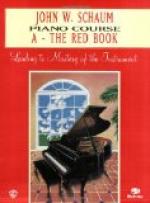One of the greatest American teachers of touch was Dr. William Mason, who made an exhaustive study of this subject. His own touch was noted for its clear, bell-like, elastic quality. He remarked on one occasion, in regard to playing in public: “It is possible I may be so nervous that I can hardly walk to the piano; but once I have begun to play I shall hold the audience still enough to hear a pin drop, simply by the beauty of my touch and tone.” Dr. Mason’s touch specialties were “pressure” and “elastic” or “drawing-off” touches. He found these gave both weight and crisp lightness to the tones.
Mr. Tobias Matthay, of London, has given much time and thought to the study of touch and key mechanism. He says: “The two chief rules of technic, as regards the key are: Always feel how much the key resists you, feel how much the key wants for every note. Second, always listen for the moment each sound begins, so that you may learn to direct your effort to the sound only and not to the key bed. It is only by making the hammer end of the key move that you can make a sound. The swifter the movement, the louder the sound. The more gradual the movement the more beautiful the quality of sound. For brilliant tone, you may hit the string by means of the key, but do not, by mistake, hit the key instead.”
Thuel Burnham, a pupil of Mason and Leschetizky, has welded the ideas of these two masters into his own experience, and simplifies the matter of piano touch as follows:
MELODY AND COLORATURA HANDS
“The position and condition of the hand varies according to the character of the music and the quality of tone you wish to produce. If you give out a melody, you want a full, luscious tone, the weight of arm on the key, everything relaxed and a clinging, caressing pressure of finger. Here you have the ‘Melody Hand,’ with outstretched, flat fingers. On the contrary, if you wish rapid passage work, with clear, bright, articulate touch, the hand must stand up in well-arched, normal playing position, with fingers well rounded and good finger action. Here you have the ‘Technical’ or ‘Coloratura Hand.’”
The distinction made by Mr. Burnham clears up the uncertainty about arched hand and articulate touch, or low hand and flat fingers. Both are used in their proper place, according to the demands of the music. The player, however, who desires a clean, reliable technic, should first acquire a coloratura hand before attempting a melody hand.
SECTION III
The Art of Practise
We have seen that if the pianist hopes to perfect himself in his art he must lay the foundation deep down in the fundamentals of hand position, body condition, correct finger movements and in careful attention to the minutest details of touch and tone production.
The remark is often heard, from persons who have just listened to a piano recital: “I would give anything in the world to play like that!” But would they even give the necessary time, to say nothing of the endless patience, tireless energy and indomitable perseverance which go to the making of a virtuoso.




